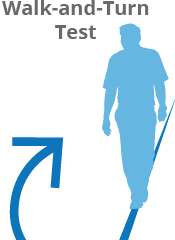Walk-and-Turn Test
Walking in a perfectly straight line (heel to toe), pivoting and doing it again can be a challenge for many people, even in the most ideal of circumstances; unfortunately, this is a feat upon which you could be graded if you are pulled over for driving under the influence. The National Highway Traffic Safety Administration (NHTSA) includes the walk-and-turn test in its list of approved field sobriety tests, and law enforcement agencies across the country use this to determine if there is probable cause for a drunk-driving arrest.
Walk-and-Turn Test Procedure
The walk and turn is a standardized test, which means that the officer who administers it must follow certain guidelines to ensure an accurate result. The test is divided into two stages: instruction and performance. During the instruction stage, the officer will ask you to stand heel to toe with your arms at the side while he or she explains and demonstrates how the test should be performed. After providing the instructions, the officer will ask if you understood.
To perform the test, you will take none heel-to-toe steps forward on an real or imaginary line, pivot, and take nine steps back. At all times, you will keep your arms to the side, watch your feet and count the steps aloud.
While you are walking, the officer will look for a number of clues that indicate a blood alcohol content (BAC) level of .10% or higher. These include: difficulty balancing while listening to instructions, starting the test before the instruction stage is complete, stopping while walking, failing to walk heel to toe, stepping off of the line, using arms for balance, turning incorrectly and taking the incorrect number of steps.
Your Test Can be Contested
According to the NHTSA, the walk-and-turn test has only a 66% accuracy rate—and that's when it's administered according to their guidelines. If you were charged with DUI after taking the field sobriety tests, it may be possible to call their accuracy into question in an effort to challenge your results.

